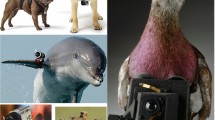Abstract
In this paper we investigate the geometry and algebra of multiple one-dimensional projections of a two-dimensional environment. This is relevant for one-dimensional cameras, e.g. as used in certain autonomous guided vehicles. It is also relevant for understanding the projection of lines in ordinary vision. A third application is on ordinary vision of vehicles undergoing so called planar motion. The structure and motion problem for such cameras is studied and the two possible minimal cases is solved. The technique of solving these questions reveal interesting ambiguities. It is shown that for each solution with three images there is an ambiguous solution. It is also shown that for each solution for four points there is an ambiguous solution. The connection between these two different types of ambiguities is also given. Although the paper deals with calibrated cameras, it is shown that similar results exist for uncalibrated cameras.
Similar content being viewed by others
References
N. Altshiller-Court, College Geometry, Barnes and Noble: New York, 1952.
M. Armstrong, A. Zisserman, and R. Hartley, “Self-calibration from image triplets,” in Proc. 4th European Conf. on Computer Vision, Cambridge, UK, Springer-Verlag, 1996, pp. 3-16.
K. Åström, “Where am I and what am I seeing? Algorithms for a Laser Guided Vehicle,” Master's Thesis, Dept. of Mathematics, Lund Institute of Technology, Sweden, 1991.
K. Åström, “Automatic mapmaking,” in Selected Papers from the 1st IFAC International Workshop on Intelligent Autonomous Vehicles, Southampton, UK, 18-21 April 1993, D. Charnley (Ed.), Pergamon Press, pp. 181-186.
K. Åström, “Invariancy methods for points, curves and surfaces in computational vision,” Ph.D. thesis, Dept. of Mathematics, Lund University, Sweden, 1996a.
K. Åström, “Multilinear constraints in two-dimensional vision and isogonal conjugacy,” in Proc. Symposium on Image Analysis, Lund, Sweden, 1996b, pp. 34-38.
K. Åström and M. Oskarsson, “Minimal structure and motion problems for 1D vision,” in Proc. Symposium on Image Analysis, Gothenburg, Sweden, 1999a, pp. 45-48.
K. Åström and M. Oskarsson, “Solutions and ambiguities of the structure and motion problem for 1D retinal vision,” in Proc. 11th Scandinavian Conference on Image Analysis, 1999b.
H.F. Baker, An Introduction to Plane Geometry, Cambridge University Press, 1943.
S. Carlsson, “Duality of reconstruction and positioning from projective views,” in IEEEWorkshop on Representation ofVisual Scenes, 1995.
S. Carlsson and D. Weinshall, “Dual computation of projective shape and camera positions from multiple images,” Int. Journal of Computer Vision, Vol. 27, No. 3, pp. 227-241, 1998.
H.S.M. Coxeter, The Real Projective Plane, 3rd edn., Springer-Verlag: New York, NY, USA, 1993.
O.D. Faugeras, L. Quan, and P. Sturm, “Self-calibration of a 1D projective camera and its application to the self-calibration of a 2D projective camera,” in Proc. 5th European Conf. on Computer Vision, Freiburg, Germany, 1998, pp. 36-52.
R. Gupta and R.I. Hartley, “Linear pushbroom cameras,” Pattern Analysis and Machine Intelligence, Vol. 19, No. 9, pp. 963-975, 1997.
K. Hyyppä, “Optical navigation system using passive identical beacons,” in Proceedings intelligent autonomous systems, Amsterdam, 1987.
C.B. Madsen, C.S. Andersen, and J.S. Sørensen, “A robustness analysis of triangulation-based robot self-positioning,” in The 5th Symposium for Intelligent Robotics Systems, Stockholm, Sweden, 1997.
J. Neira, I. Ribeiro, and J.D. Tardos, “Mobile robot localization and map building using monocular vision,” in The 5th Symposium for Intelligent Robotics Systems, Stockholm, Sweden, 1997, pp. 275-284.
L. Quan and T. Kanade, “Affine structure from line correspondences with uncalibrated affine cameras,” IEEE Trans. Pattern Analysis and Machine Intelligence, Vol. 19, No. 8, pp. 834-845, 1997.
A. Shahsua, “Algebraic functions for recognition,” IEEE Trans. Pattern Analysis and Machine Intelligence, Vol. 17, No. 8, 1995.
C. Slama (Ed.), Manual of Photogrammetry, 4th edn., American Society of Photogrammetry: Falls Church, VA, 1984.
M.E. Spetsakis and J. Aloimonos,“A unified theory of structure from motion,” in Proc.DARPAIUWorkshop, 1990, pp. 271-283.
B. Triggs, “Matching constraints and the joint image,” in Proc. ICCV'95, 1995, pp. 338-343.
Author information
Authors and Affiliations
Rights and permissions
About this article
Cite this article
Åström, K., Oskarsson, M. Solutions and Ambiguities of the Structure and Motion Problem for 1D Retinal Vision. Journal of Mathematical Imaging and Vision 12, 121–135 (2000). https://doi.org/10.1023/A:1008362322190
Issue Date:
DOI: https://doi.org/10.1023/A:1008362322190




